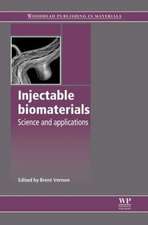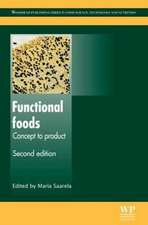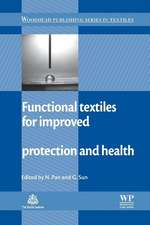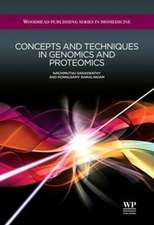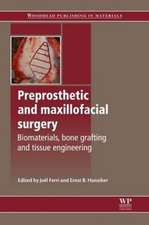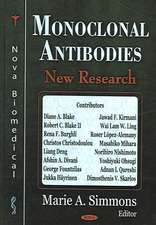Reducing Saturated Fats in Foods: Woodhead Publishing Series in Food Science, Technology and Nutrition
Editat de G Talboten Limba Engleză Paperback – 18 aug 2016
- Reviews the sources and effects of saturated fats in food and the ways in which the food industry can effectively reduce saturates
- Explores the functional and nutritional aspects of saturated fats in foods, covering sources of dietary saturated fats and their functional attributes
- Focuses on reducing saturated fats through food reformulation, concentrating on both the technologies used and the food categories affected
Din seria Woodhead Publishing Series in Food Science, Technology and Nutrition
- 15%
 Preț: 391.19 lei
Preț: 391.19 lei - 24%
 Preț: 1333.02 lei
Preț: 1333.02 lei - 24%
 Preț: 1210.03 lei
Preț: 1210.03 lei - 24%
 Preț: 946.43 lei
Preț: 946.43 lei - 9%
 Preț: 1205.99 lei
Preț: 1205.99 lei - 24%
 Preț: 1189.10 lei
Preț: 1189.10 lei - 9%
 Preț: 984.09 lei
Preț: 984.09 lei - 9%
 Preț: 1006.66 lei
Preț: 1006.66 lei - 24%
 Preț: 960.56 lei
Preț: 960.56 lei - 23%
 Preț: 1419.50 lei
Preț: 1419.50 lei - 9%
 Preț: 1206.85 lei
Preț: 1206.85 lei - 9%
 Preț: 922.07 lei
Preț: 922.07 lei - 24%
 Preț: 1192.22 lei
Preț: 1192.22 lei - 9%
 Preț: 1215.75 lei
Preț: 1215.75 lei - 24%
 Preț: 1162.37 lei
Preț: 1162.37 lei - 9%
 Preț: 950.09 lei
Preț: 950.09 lei - 24%
 Preț: 1162.62 lei
Preț: 1162.62 lei - 24%
 Preț: 801.31 lei
Preț: 801.31 lei - 27%
 Preț: 379.84 lei
Preț: 379.84 lei - 29%
 Preț: 1336.07 lei
Preț: 1336.07 lei - 24%
 Preț: 798.74 lei
Preț: 798.74 lei - 9%
 Preț: 1018.93 lei
Preț: 1018.93 lei - 24%
 Preț: 1081.43 lei
Preț: 1081.43 lei - 24%
 Preț: 1185.22 lei
Preț: 1185.22 lei - 31%
 Preț: 922.77 lei
Preț: 922.77 lei - 24%
 Preț: 1131.77 lei
Preț: 1131.77 lei - 23%
 Preț: 1635.86 lei
Preț: 1635.86 lei - 9%
 Preț: 1277.62 lei
Preț: 1277.62 lei - 24%
 Preț: 1049.04 lei
Preț: 1049.04 lei - 24%
 Preț: 1134.60 lei
Preț: 1134.60 lei - 9%
 Preț: 1076.36 lei
Preț: 1076.36 lei - 24%
 Preț: 1158.21 lei
Preț: 1158.21 lei - 9%
 Preț: 1065.06 lei
Preț: 1065.06 lei - 9%
 Preț: 1067.39 lei
Preț: 1067.39 lei - 24%
 Preț: 812.03 lei
Preț: 812.03 lei - 9%
 Preț: 1203.13 lei
Preț: 1203.13 lei - 23%
 Preț: 1237.19 lei
Preț: 1237.19 lei - 24%
 Preț: 948.79 lei
Preț: 948.79 lei - 23%
 Preț: 1138.06 lei
Preț: 1138.06 lei - 9%
 Preț: 868.43 lei
Preț: 868.43 lei - 24%
 Preț: 871.98 lei
Preț: 871.98 lei - 20%
 Preț: 1272.59 lei
Preț: 1272.59 lei - 29%
 Preț: 1195.06 lei
Preț: 1195.06 lei - 9%
 Preț: 1045.58 lei
Preț: 1045.58 lei - 9%
 Preț: 1002.45 lei
Preț: 1002.45 lei - 9%
 Preț: 505.72 lei
Preț: 505.72 lei - 9%
 Preț: 1062.13 lei
Preț: 1062.13 lei - 24%
 Preț: 1306.94 lei
Preț: 1306.94 lei
Preț: 1043.52 lei
Preț vechi: 1146.73 lei
-9% Nou
Puncte Express: 1565
Preț estimativ în valută:
199.70€ • 207.72$ • 164.87£
199.70€ • 207.72$ • 164.87£
Carte tipărită la comandă
Livrare economică 07-21 aprilie
Preluare comenzi: 021 569.72.76
Specificații
ISBN-13: 9780081017135
ISBN-10: 0081017138
Pagini: 416
Dimensiuni: 156 x 234 x 22 mm
Greutate: 0.58 kg
Editura: ELSEVIER SCIENCE
Seria Woodhead Publishing Series in Food Science, Technology and Nutrition
ISBN-10: 0081017138
Pagini: 416
Dimensiuni: 156 x 234 x 22 mm
Greutate: 0.58 kg
Editura: ELSEVIER SCIENCE
Seria Woodhead Publishing Series in Food Science, Technology and Nutrition
Cuprins
Contributor contact details
Woodhead Publishing Series in Food Science, Technology and Nutrition
Part I: Saturated fats in foods: functional and nutritional aspects
Chapter 1: Saturated fats in foods and strategies for their replacement: an introduction
Abstract:
1.1 Background to the need to reduce saturated fats
1.2 Chemistry and structure of fatty acids and triglycerides
1.3 Saturated fat and fatty acid consumption in the EU, US and UK
1.4 Opposing views on effects of saturates on cardiovascular disease
1.5 Replacements for saturates
1.6 Areas not covered by specific chapters in this book
1.7 Future trends
1.8 Sources of further information and advice
Chapter 2: The functional attributes that fats bring to food
Abstract:
2.1 Introduction
2.2 Perception of fat
2.3 Role of fat in the texture of foods
2.4 Engineering fat to tailor appetite
2.5 Consequences for strategies to reduce fat
2.6 Future trends
2.7 Sources of further information and advice
2.8 Acknowledgements
Chapter 3: Sources of saturated and other dietary fats
Abstract:
3.1 Introduction
3.2 Vegetable oils rich in saturated fats
3.3 Mammalian milk fats
3.4 Animal carcass fats
3.5 Hydrogenated fats
3.6 The trans effect
3.7 Future trends
3.8 Sources of further information and advice
Chapter 4: Health aspects of saturated fatty acids
Abstract:
4.1 Introduction
4.2 Atherosclerosis as the basis for cardiovascular diseases (CVD)
4.3 Effects of individual fatty acids on plasma total cholesterol, LDL cholesterol, HDL cholesterol and triglycerides (VLDL)
4.4 Effects of fatty acids on other biomarkers related to coronary heart disease (CHD)
4.5 Evidence linking LDL cholesterol to the development of atherosclerosis and CHD
4.6 Effects of saturated fatty acids (SFA) on disease states related to CVD
4.7 Cancer
4.8 Dietary recommendations related to SFA
4.9 Trends in consumption of SFA as related to trends in mortality and incidence of CVD
4.10 Conclusion
Chapter 5: Chronic disease risk associated with different dietary saturated fatty acids
Abstract:
5.1 Introduction
5.2 Key dietary saturated fatty acids
5.3 Chronic disease risk differences between different saturated fatty acids
104 Reducing saturated fats in foods
5.4 The ‘stearic acid’ effect – chronic disease risk effects of stearic acid
5.5 Future trends
Chapter 6: Nutritional characteristics of palm oil
Abstract:
6.1 Introduction
6.2 Serum cholesterol, lipoproteins and dietary fatty acids
6.3 Effects of palm olein as part of a low-fat healthy diet
6.4 Effects of dietary fatty acids on LDL-C/HDL-C ratios
6.5 Palm oil minor components
6.6 Conclusion and future trends
6.7 Sources of further information and advice
Part II: Food reformulation to reduce saturated fats
Chapter 7: Reducing saturated fat using emulsion technology
Abstract:
7.1 Introduction
7.2 Fat composition
7.3 Emulsion droplets
7.4 Phase structuring and emulsions
7.5 Fat replacers
7.6 Processing
7.7 Applications
7.8 Future trends
7.9 Sources of further information and advice
Chapter 8: Diacylglycerol oils: nutritional aspects and applications in foods
Abstract:
8.1 Introduction
8.2 Digestion, absorption and metabolism of DAG
8.3 Production process patents
8.4 Product application patents
8.44 DAG oil composition containing phytosterols
8.5 Regulatory status
8.6 Future trends
8.7 Source of further information
Chapter 9: Saturated fat reduction in milk and dairy products
Abstract:
9.1 Introduction
9.2 Milk
9.3 Cheese
9.4 Butter and spreadable fats
9.5 Reducing the saturated content of milk fat through feed
9.6 Future trends
9.7 Sources of further information and advice
Chapter 10: Saturated fat reduction in butchered meat
Abstract:
10.1 Introduction
10.2 Animal production
10.3 Preparation of cuts
10.4 In the kitchen and on the plate
10.5 Effect on meat quality
10.6 Future trends
10.7 Conclusions
10.8 Sources of further information and advice
Chapter 11: Saturated fat reduction in processed meat products
Abstract:
11.1 Introduction
11.2 Ground-meat products (burgers)
11.3 Sausages – coarse-ground (e.g. cooked salami, breakfast sausage)
11.4 Sausages – emulsion-type products (e.g. bologna, frankfurters)
11.5 Sausages – dry fermented (e.g. summer sausage, dry salami)
11.6 Prepared and coated meat products (e.g. nuggets, pies)
11.7 Future trends
11.8 Sources of further information
Chapter 12: Altering animal diet to reduce saturated fat in meat and milk
Abstract:
12.1 Introduction
12.2 The fat content of meat and milk
12.3 Dietary effects on the fat content and fatty acid composition of meat
12.4 Dietary effects on the fat content and fatty acid composition of milk
12.5 Influence of ‘additives’ on saturated fatty acids in meat and milk
12.6 Future trends
12.7 Sources of further information and advice
Chapter 13: Reducing saturated fat in savoury snacks and fried foods
Abstract:
13.1 Introduction
13.2 Frying oils
13.3 Effects of frying oils and frying parameters on the quality of fried foods
13.4 Innovating technologies in frying and their impact on the quality of fried foods
13.5 Changes in savoury snacks
13.6 Future trends
Chapter 14: Saturated fat reduction in biscuits
Abstract:
14.1 Introduction
14.2 Types of fat used in biscuits
14.3 The technology of biscuits
14.4 Techniques for saturates reduction
14.5 Future trends
14.6 Sources of further information and advice
Chapter 15: Saturated fat reduction in pastry
Abstract:
15.1 Introduction
15.2 The dough/fat matching process in pastry
15.3 Process rheological modeling
15.4 Margarine and shortenings for reducing saturated fats
15.5 Conclusions
15.6 Future trends
15.8 Acknowledgments
Chapter 16: Reducing saturated fat in chocolate, compound coatings and filled confectionery products
Abstract:
16.1 Introduction
16.2 Chocolate
16.3 Compound coatings
16.4 Filled confectionery products
16.5 Future trends
16.6 Sources of further information and advice
Chapter 17: Saturated fat reduction in ice cream
Abstract:
17.1 Introduction
17.2 Basic components and processing of ice cream
17.3 Sources of fat and saturated fat in ice cream products
17.4 The function of fat in ice cream
17.5 Properties of fats used in current ice cream products
17.6 Challenges associated with saturated fatty acid (SFA) reduction
17.7 Future trends
Chapter 18: Saturated fat reduction in sauces
Abstract:
18.1 Introduction
18.2 Sensory properties of sauces
18.3 Product lifetime
18.4 Conclusions
18.5 Future trends
Index
Woodhead Publishing Series in Food Science, Technology and Nutrition
Part I: Saturated fats in foods: functional and nutritional aspects
Chapter 1: Saturated fats in foods and strategies for their replacement: an introduction
Abstract:
1.1 Background to the need to reduce saturated fats
1.2 Chemistry and structure of fatty acids and triglycerides
1.3 Saturated fat and fatty acid consumption in the EU, US and UK
1.4 Opposing views on effects of saturates on cardiovascular disease
1.5 Replacements for saturates
1.6 Areas not covered by specific chapters in this book
1.7 Future trends
1.8 Sources of further information and advice
Chapter 2: The functional attributes that fats bring to food
Abstract:
2.1 Introduction
2.2 Perception of fat
2.3 Role of fat in the texture of foods
2.4 Engineering fat to tailor appetite
2.5 Consequences for strategies to reduce fat
2.6 Future trends
2.7 Sources of further information and advice
2.8 Acknowledgements
Chapter 3: Sources of saturated and other dietary fats
Abstract:
3.1 Introduction
3.2 Vegetable oils rich in saturated fats
3.3 Mammalian milk fats
3.4 Animal carcass fats
3.5 Hydrogenated fats
3.6 The trans effect
3.7 Future trends
3.8 Sources of further information and advice
Chapter 4: Health aspects of saturated fatty acids
Abstract:
4.1 Introduction
4.2 Atherosclerosis as the basis for cardiovascular diseases (CVD)
4.3 Effects of individual fatty acids on plasma total cholesterol, LDL cholesterol, HDL cholesterol and triglycerides (VLDL)
4.4 Effects of fatty acids on other biomarkers related to coronary heart disease (CHD)
4.5 Evidence linking LDL cholesterol to the development of atherosclerosis and CHD
4.6 Effects of saturated fatty acids (SFA) on disease states related to CVD
4.7 Cancer
4.8 Dietary recommendations related to SFA
4.9 Trends in consumption of SFA as related to trends in mortality and incidence of CVD
4.10 Conclusion
Chapter 5: Chronic disease risk associated with different dietary saturated fatty acids
Abstract:
5.1 Introduction
5.2 Key dietary saturated fatty acids
5.3 Chronic disease risk differences between different saturated fatty acids
104 Reducing saturated fats in foods
5.4 The ‘stearic acid’ effect – chronic disease risk effects of stearic acid
5.5 Future trends
Chapter 6: Nutritional characteristics of palm oil
Abstract:
6.1 Introduction
6.2 Serum cholesterol, lipoproteins and dietary fatty acids
6.3 Effects of palm olein as part of a low-fat healthy diet
6.4 Effects of dietary fatty acids on LDL-C/HDL-C ratios
6.5 Palm oil minor components
6.6 Conclusion and future trends
6.7 Sources of further information and advice
Part II: Food reformulation to reduce saturated fats
Chapter 7: Reducing saturated fat using emulsion technology
Abstract:
7.1 Introduction
7.2 Fat composition
7.3 Emulsion droplets
7.4 Phase structuring and emulsions
7.5 Fat replacers
7.6 Processing
7.7 Applications
7.8 Future trends
7.9 Sources of further information and advice
Chapter 8: Diacylglycerol oils: nutritional aspects and applications in foods
Abstract:
8.1 Introduction
8.2 Digestion, absorption and metabolism of DAG
8.3 Production process patents
8.4 Product application patents
8.44 DAG oil composition containing phytosterols
8.5 Regulatory status
8.6 Future trends
8.7 Source of further information
Chapter 9: Saturated fat reduction in milk and dairy products
Abstract:
9.1 Introduction
9.2 Milk
9.3 Cheese
9.4 Butter and spreadable fats
9.5 Reducing the saturated content of milk fat through feed
9.6 Future trends
9.7 Sources of further information and advice
Chapter 10: Saturated fat reduction in butchered meat
Abstract:
10.1 Introduction
10.2 Animal production
10.3 Preparation of cuts
10.4 In the kitchen and on the plate
10.5 Effect on meat quality
10.6 Future trends
10.7 Conclusions
10.8 Sources of further information and advice
Chapter 11: Saturated fat reduction in processed meat products
Abstract:
11.1 Introduction
11.2 Ground-meat products (burgers)
11.3 Sausages – coarse-ground (e.g. cooked salami, breakfast sausage)
11.4 Sausages – emulsion-type products (e.g. bologna, frankfurters)
11.5 Sausages – dry fermented (e.g. summer sausage, dry salami)
11.6 Prepared and coated meat products (e.g. nuggets, pies)
11.7 Future trends
11.8 Sources of further information
Chapter 12: Altering animal diet to reduce saturated fat in meat and milk
Abstract:
12.1 Introduction
12.2 The fat content of meat and milk
12.3 Dietary effects on the fat content and fatty acid composition of meat
12.4 Dietary effects on the fat content and fatty acid composition of milk
12.5 Influence of ‘additives’ on saturated fatty acids in meat and milk
12.6 Future trends
12.7 Sources of further information and advice
Chapter 13: Reducing saturated fat in savoury snacks and fried foods
Abstract:
13.1 Introduction
13.2 Frying oils
13.3 Effects of frying oils and frying parameters on the quality of fried foods
13.4 Innovating technologies in frying and their impact on the quality of fried foods
13.5 Changes in savoury snacks
13.6 Future trends
Chapter 14: Saturated fat reduction in biscuits
Abstract:
14.1 Introduction
14.2 Types of fat used in biscuits
14.3 The technology of biscuits
14.4 Techniques for saturates reduction
14.5 Future trends
14.6 Sources of further information and advice
Chapter 15: Saturated fat reduction in pastry
Abstract:
15.1 Introduction
15.2 The dough/fat matching process in pastry
15.3 Process rheological modeling
15.4 Margarine and shortenings for reducing saturated fats
15.5 Conclusions
15.6 Future trends
15.8 Acknowledgments
Chapter 16: Reducing saturated fat in chocolate, compound coatings and filled confectionery products
Abstract:
16.1 Introduction
16.2 Chocolate
16.3 Compound coatings
16.4 Filled confectionery products
16.5 Future trends
16.6 Sources of further information and advice
Chapter 17: Saturated fat reduction in ice cream
Abstract:
17.1 Introduction
17.2 Basic components and processing of ice cream
17.3 Sources of fat and saturated fat in ice cream products
17.4 The function of fat in ice cream
17.5 Properties of fats used in current ice cream products
17.6 Challenges associated with saturated fatty acid (SFA) reduction
17.7 Future trends
Chapter 18: Saturated fat reduction in sauces
Abstract:
18.1 Introduction
18.2 Sensory properties of sauces
18.3 Product lifetime
18.4 Conclusions
18.5 Future trends
Index
Recenzii
"This publication provides an excellent "state of the art" review of the subject area. The contents have been well selected and cover all the important aspects." --Food Science and Technology
"This book should be of interest to nutritionists, legislators on food issues, and to those working in the food industry." --Lipid Technology
"This book should be of interest to nutritionists, legislators on food issues, and to those working in the food industry." --Lipid Technology

